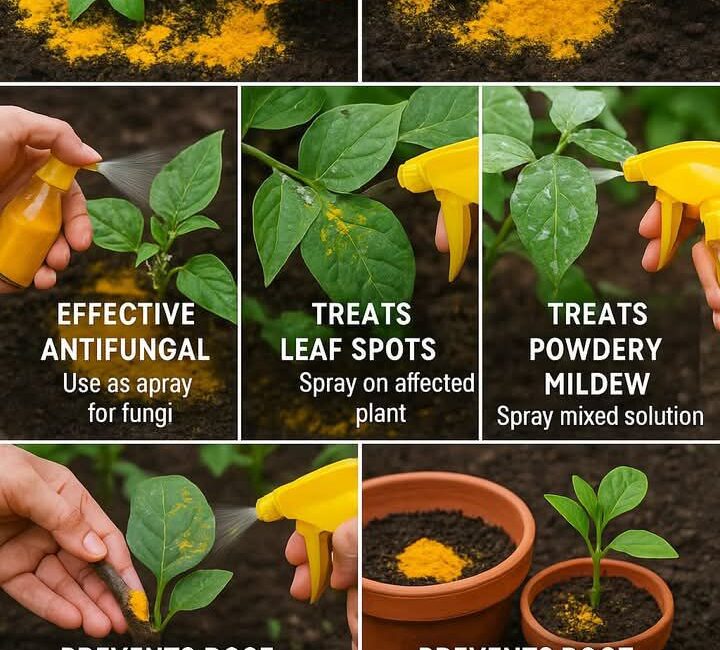Turmeric, often associated with vibrant curry dishes and powerful health benefits for humans, is slowly becoming a go-to natural remedy for gardening enthusiasts. The bright yellow spice, derived from the root of the Curcuma longa plant, has gained significant attention not only for its medicinal uses but also for its benefits to plants. As gardeners are increasingly looking for natural alternatives to synthetic pesticides and fertilizers, turmeric has emerged as a secret remedy for improving plant health, repelling pests, and preventing plant diseases.
In this article, we will explore the various ways turmeric can be utilized in the garden, its role in maintaining plant health, and how to use it effectively. From warding off pests like ants and mealybugs to promoting root development and preventing fungal diseases, turmeric offers a broad range of applications that gardeners may not be aware of. We will dive into the science behind turmeric’s properties and discuss step-by-step how to use it for different gardening needs. By the end of this article, you’ll understand why turmeric might just be the gardening hack you’ve been looking for.
Understanding Turmeric’s Active Ingredients
Before diving into the applications of turmeric in the garden, it’s important to understand what makes this humble root so effective. Turmeric contains several bioactive compounds, but the most notable is curcumin, which gives turmeric its yellow color. Curcumin has been extensively studied for its medicinal properties, and its anti-inflammatory, antifungal, antibacterial, and antioxidant qualities are what make it valuable not only for humans but for plants as well.
These properties allow turmeric to fight off plant diseases, promote healing in plant wounds, and protect against harmful pests. Curcumin, along with other compounds in turmeric like turmerones, helps boost plant immunity and prevents infections caused by fungi and bacteria. Additionally, turmeric has been found to improve soil health by acting as a natural compost and promoting microbial activity in the soil. This makes turmeric an invaluable tool in organic gardening.
1. Turmeric as a Natural Ant Repellent
Ants can be a nuisance in the garden, especially when they begin farming aphids or carrying harmful bacteria to your plants. Many gardeners have found that turmeric’s distinctive scent is a powerful deterrent to ants. The strong, pungent aroma of turmeric disrupts the ants’ trail and forces them to abandon the area.
How to Use:
To use turmeric as an ant repellent, sprinkle turmeric powder around the base of the plants that are being overrun by ants. Apply sparingly as a little goes a long way. You can also mix turmeric powder with a small amount of water and pour it around the base of the plant or on the soil where the ants are entering.
Additionally, turmeric can be mixed with other natural ingredients like cinnamon or black pepper for an enhanced ant-repelling effect. These combinations can disrupt the ants’ pheromone trail and keep them away from your garden. Repeat the process as needed to maintain the repellent effect.
2. Turmeric to Repel Mealybugs
Mealybugs are another common pest in the garden, particularly on indoor plants. These tiny, soft-bodied insects often appear as white, cotton-like clumps on the stems and leaves of plants. Mealybugs tend to feed on plant sap and can weaken the plant by draining it of essential nutrients. What’s worse, mealybugs are often protected by ants, which tend to farm them for their sugary secretions (honeydew).
Since turmeric is an effective repellent for ants, by using it in areas where mealybugs are present, you can simultaneously get rid of both pests.
How to Use:
Sprinkle turmeric powder on the surface of the soil around affected plants. This will deter both ants and mealybugs. Alternatively, you can make a turmeric spray by mixing 2 teaspoons of turmeric powder in 1 liter of water. Shake the mixture well, then spray it directly on the affected plant areas, ensuring to cover the leaves, stems, and any visible mealybugs.
3. Turmeric as a Natural Pesticide
Turmeric’s antifungal and antimicrobial properties make it a fantastic natural pesticide. Gardeners have used turmeric for years to combat common garden pests like cabbage loopers, gray worms, and even aphids. Unlike synthetic pesticides, which can be harmful to beneficial insects, turmeric is gentle on the environment and poses no threat to pollinators like bees and butterflies.
How to Use:
To make a simple pesticide, mix 2 teaspoons of turmeric powder in 1 liter of water. Pour the mixture into a spray bottle, shake it well, and apply it to the affected plants. This solution can be used to repel a wide range of pests, from aphids to caterpillars. You can repeat this process every few days until you see a reduction in pest activity.
If you are dealing with a particularly severe infestation, turmeric can be combined with other natural insect-repelling ingredients like neem oil, garlic, or dish soap for added potency.
4. Turmeric as an Antifungal Remedy
Fungal diseases are a common problem for gardeners, especially in humid conditions. Turmeric’s antifungal properties make it a powerful ally in the fight against plant diseases like powdery mildew, black spot, and rust. The curcumin in turmeric inhibits the growth of fungal pathogens, helping to protect your plants from fungal infections that can damage leaves, flowers, and fruit.
How to Use:
To create a turmeric-based antifungal solution, mix 2 teaspoons of turmeric powder with 1 liter of water. Pour the mixture into a spray bottle and shake it thoroughly before applying it to the leaves and stems of infected plants. Spray this solution on a weekly basis or when you notice any signs of fungal growth, such as white powdery spots or discolored leaves.
For more serious fungal infections, turmeric can be combined with baking soda or milk for additional effectiveness. The combination of these ingredients helps to create an environment where fungi cannot thrive.
5. Treating Leaf Spots with Turmeric
Leaf spots, often caused by fungal infections or bacteria, are a common sight in many gardens. These unsightly lesions can cause a plant’s leaves to turn yellow, brown, or black and may eventually cause the plant to lose its leaves entirely. Fortunately, turmeric can be used as an effective treatment for leaf spots.
How to Use:
Mix 2 teaspoons of turmeric powder with 1 liter of water, and pour it into a spray bottle. Shake the mixture well, and spray it directly on the affected leaves, ensuring the entire surface is covered. The antifungal properties of turmeric will help to control the infection and prevent it from spreading.
Additionally, it’s a good idea to remove any heavily infected leaves and dispose of them properly to prevent the disease from spreading further.
6. Turmeric to Treat Powdery Mildew
Powdery mildew is a common fungal infection that affects a variety of plants, including squash, cucumbers, and roses. It typically appears as white, powdery spots on leaves, stems, and buds. If left untreated, powdery mildew can stunt growth and reduce the yield of your plants.
How to Use:
A turmeric spray can help control and prevent powdery mildew. Combine 2 teaspoons of turmeric powder, 100 ml of milk, and 2 teaspoons of white vinegar in 1 liter of water. Shake the mixture well and spray it onto the infected plants. The combination of turmeric and milk helps to disrupt the growth of the mildew while also adding beneficial nutrients to the plant.
The vinegar helps to acidify the solution, making it inhospitable for the mildew to thrive. Apply this solution once a week or as needed, depending on the severity of the infection.
7. Preventing Rose Bush Dieback with Turmeric
Rose bushes are susceptible to a number of diseases, including rose dieback, which causes the plant to die from the tip of the stem downward. Turmeric can be used to prevent this condition by applying it to the cut ends of rose stems.
How to Use:
Prepare a thick paste by mixing water and turmeric powder. After cutting back your rose bush or trimming damaged stems, apply the turmeric paste to the cut surface. This paste acts as a protective barrier, preventing harmful pathogens from entering the plant and causing infection.
This method can be particularly useful when pruning your rose bushes in the spring or after heavy blooms.
8. Preventing Root Rot with Turmeric
Root rot is a serious issue for many gardeners, especially those growing plants in pots or containers. This condition is often caused by overwatering and poor drainage, and it can lead to the death of the plant. Turmeric can be used to prevent root rot by improving soil health and promoting better drainage.
How to Use:
For potted plants, mix 1 tablespoon of turmeric powder into 5 liters of potting soil. This will help to reduce the likelihood of root rot by promoting healthy microbial activity in the soil. For plants in the ground, water your plants with a mixture of 1 teaspoon of turmeric in 1 liter of water. This solution helps to improve the soil’s structure and makes it more conducive to healthy root growth.
Additionally, turmeric can help to balance the soil’s pH, creating an environment that is more favorable for root development and preventing the growth of harmful fungi.
9. Healing Plant Wounds with Turmeric
Just like humans, plants can suffer injuries, whether from pests, pruning, or environmental factors. These wounds can become entry points for diseases and pathogens. Turmeric, with its antiseptic and anti-inflammatory properties, can help to heal these wounds and protect the plant from infection.
How to Use:
Prepare a paste by mixing turmeric powder with a small amount of water. Apply the paste directly to the wound or cut on the plant. The turmeric will act as a protective barrier and help to promote healing.
This remedy can be particularly useful for trees, shrubs, or larger plants that suffer from pruning cuts or physical damage.
10. Promoting Root Development with Turmeric
Turmeric can be used to encourage root development in plant cuttings. It functions similarly to a rooting hormone, promoting faster and stronger root growth.
How to Use:
Add 1 tablespoon of turmeric powder to the potting soil when planting cuttings. The turmeric will help to stimulate the growth of new roots, improving the success rate of your cuttings.
Alternatively, you can make a turmeric dip by mixing turmeric powder with water and dipping the cut end of your cutting into the solution before planting it in the soil.
Conclusion: Embrace the Power of Turmeric in Your Garden
Turmeric is not only a kitchen staple but also an incredibly valuable tool in organic gardening. From its ability to repel pests like ants and mealybugs to its antifungal properties that help treat powdery mildew and leaf spots, turmeric offers a natural, safe, and effective alternative to synthetic chemicals. Whether you’re dealing with a specific pest problem, a fungal infection, or simply want to promote
better plant health, turmeric can be a valuable addition to your gardening toolkit.
As more and more gardeners turn to eco-friendly solutions, turmeric stands out as a versatile and powerful remedy. By utilizing this golden spice in your garden, you can enjoy healthier, more vibrant plants while avoiding harmful chemicals. So the next time you find yourself in need of a natural remedy, consider reaching for the turmeric—your plants will thank you.




